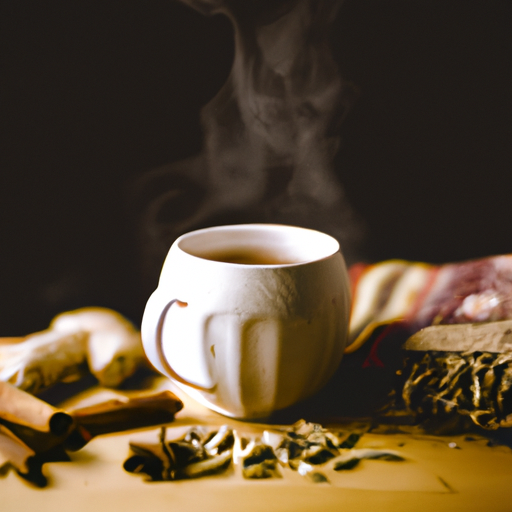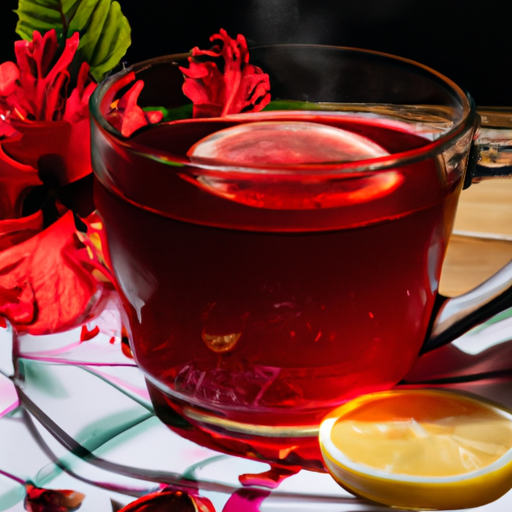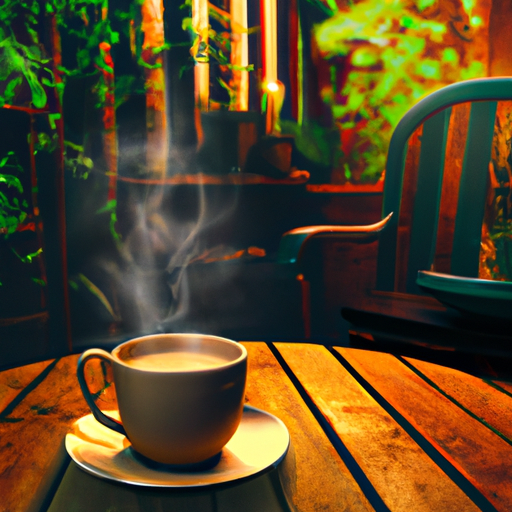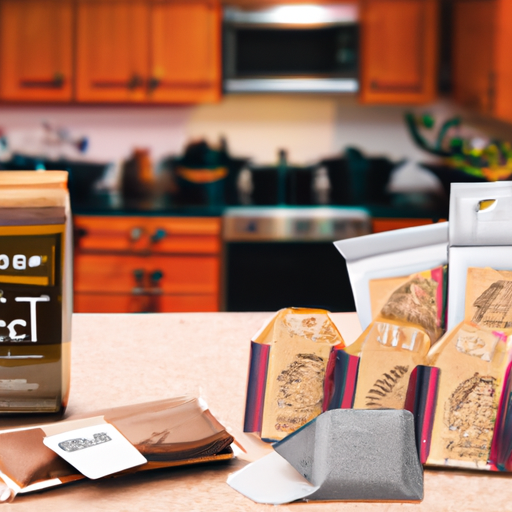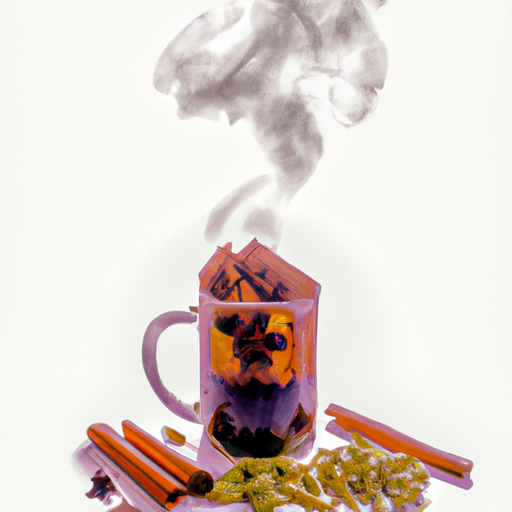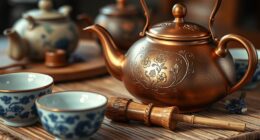I’ve always enjoyed drinking tea, however, in recent years, my affection for chai tea has significantly increased. Thanks to its bold spices and robust taste, chai offers a comforting and gratifying drink experience, whether served hot or cold. Nevertheless, the vast array of chai tea varieties and brands available can make the task of selecting the finest one rather daunting.
In this article, I will delve into the history and origin of chai tea, explore the various types of chai available, discuss the spices commonly used in chai blends and how they affect the taste profile, provide tips for making the perfect cup of chai at home, highlight some health benefits of drinking chai, examine how different cultures around the world enjoy their versions of this beloved brew, recommend some top brands for purchasing high-quality chai tea leaves or bags, and even share some easy DIY recipes for making your own signature blend.
So sit back with a steaming mug of your favorite chai blend as we embark on our journey to discover what truly makes for the best cuppa!
Key Takeaways
- Chai tea is a popular worldwide drink with a rich spice and bold flavor.
- There are many types and brands of chai tea available, and personal preference is the ultimate factor in choosing the best brand.
- Chai tea has potential health benefits due to the anti-inflammatory properties of the spices commonly used and the compounds found in black tea.
- Brewing time and balance of spices are important for a perfect blend of chai tea.
History and Origin of Chai Tea
Did you know that chai tea originated in India during the British colonial era, and was originally made with black tea, milk, sugar, and spices such as cardamom, cinnamon, ginger, and cloves? These spices are an integral part of Indian cuisine and culture.
In fact, they’ve been used for centuries in Ayurvedic medicine to treat a variety of ailments. Chai has deep cultural significance in India.
It’s often served to guests as a sign of hospitality and welcome. It’s also a staple beverage enjoyed by millions of Indians every day. The aroma of chai wafting through the air is a familiar scent that can be found on almost every street corner in India.
The traditional recipe for chai has evolved over time to include different variations depending on personal preference or regional differences. In the next section, we’ll explore some of these different types of chai and how they differ from one another.
The Different Types of Chai
You might be surprised to learn that there are many variations of the popular spiced beverage, chai tea. From masala chai to Kashmiri chai and Thai tea with spices, there isn’t a single recipe that defines this drink.
Each variation boasts a unique blend of spices and flavors, making it a favorite among tea enthusiasts worldwide. One popular chai blend is Masala Chai. This traditional Indian tea typically incorporates ginger, cardamom, cinnamon, cloves, and black peppercorns. The result is a strong and spicy brew that pairs perfectly with milk and sugar.
Another favorite is Kashmiri Chai which features green tea leaves mixed with saffron strands, almonds, cardamom pods and cinnamon sticks. It has a milder flavor than Masala Chai but still packs in enough spice to make your taste buds dance.
If you have a sweet tooth or prefer lighter flavors in your drinks then Thai Tea with Spices may be the perfect choice for you. This popular variant adds condensed milk to the mix which gives it its characteristic creaminess while also incorporating star anise and vanilla bean for added sweetness.
With so many different chai tea variations out there to choose from, it’s easy to find one that suits your taste buds just right. Understanding the spices used in chai can help you appreciate each variation even more fully. From the fiery kick of ginger to the sweet aroma of cinnamon, each individual ingredient works together seamlessly to create a harmonious balance of flavors within each cup of chai tea.
So, next time you take a sip of this delicious beverage, remember all the hard work that went into creating its unique combination of ingredients!
Understanding the Spices Used in Chai
Get ready to savor the complex flavors of your next cup of chai, as we delve into the spices commonly used in this beloved beverage. Chai is known for its warm and inviting aroma that comes from a blend of common chai spices. These spices are typically added to black tea and milk, creating a deliciously fragrant and flavorful drink that has become popular all over the world.
Here’s a table that outlines some of the most common chai spices:
| Spice | Flavor Profile | Health Benefits |
|---|---|---|
| Cinnamon | Sweet and Spicy | May lower blood sugar levels |
| Ginger | Bright and Earthy | Anti-inflammatory properties |
| Cardamom | Floral and Citrusy | Aids digestion |
Aside from being delicious on their own, these spices work together to create a unique taste profile that pairs well with many different foods. When choosing which food to pair with your chai, consider the dominant flavor notes in your blend. For instance, if you have a chai with strong cinnamon undertones, try pairing it with baked goods like cinnamon rolls or apple pie.
Understanding how the spices affect the flavor of chai is key to finding the perfect blend for your personal tastes. In our next section, we’ll dive deeper into each spice’s unique characteristics and how they interact with one another in order to help you identify which blend is best suited for you.
How the Spices Affect the Flavor of Chai
Prepare to have your taste buds tantalized as we explore how these aromatic spices work together to create the unique and delicious flavor of chai. Chai is known for its blend of spices, which includes cinnamon, cardamom, cloves, ginger, and black pepper.
Each spice brings a distinct flavor profile that adds depth and complexity to the drink. Cinnamon provides a sweet warmth while cardamom has a floral citrusy note that gives balance to the blend. Cloves add a pungent sweetness while ginger provides heat and black pepper adds an earthy spiciness.
Pairing chai with food can be quite enjoyable since it has a bold flavor that can complement various dishes. When experimenting with different spice combinations, it’s important to consider the intensity of each spice in relation to the dish you plan on pairing with it.
For example, if you’re having a spicy Indian curry with your chai tea, you may want to opt for less ginger or black pepper in your tea so that the flavors don’t clash. On the other hand, if you’re having something more mild like baked goods or pastries, adding more cinnamon or cardamom can bring out their sweetness even more.
Overall, the way spices are combined plays an essential role in creating chai’s signature taste. It’s fascinating how such seemingly opposing flavors like sweet and spicy can harmonize so well together when blended correctly. As someone who appreciates nuanced flavors and aromas, I enjoy experimenting with different homemade blends of chai using varying ratios of spices until I find my perfect combination.
As we dive into tips for making the perfect cup of chai in our subsequent section about ‘tips for making…’, remember that there’s no one-size-fits-all approach when it comes to brewing chai tea; experimentation is key!
Tips for Making the Perfect Cup of Chai
When brewing your own cup of chai, it’s important to keep in mind that the key to a perfect blend lies in finding the right balance of spices. The spice ratio is crucial for achieving a well-rounded flavor profile. Too much cinnamon, for example, can make the tea taste too sweet and overpowering. On the other hand, not enough cardamom can result in a bland and uninspiring drink.
In addition to getting the spice ratio just right, the brewing time also plays an important role in creating a delicious cup of chai. Over-steeping can lead to bitter flavors while under-steeping may leave you with weak and watery tea. Generally, steeping for 3-5 minutes should suffice depending on your personal preference.
As you perfect your chai-making skills by adjusting spice ratios and brew times to suit your taste buds, it’s worth noting that drinking this flavorful beverage has potential health benefits as well. From reducing inflammation to aiding digestion, there are many reasons why incorporating chai into your daily routine could be good for you.
Health Benefits of Chai
You can boost your overall health by incorporating a cup of this aromatic beverage into your daily routine, as chai is known to provide numerous health benefits.
For starters, the spices commonly used in chai tea have been found to aid digestion. Ginger, cinnamon, and cloves all possess anti-inflammatory properties that help soothe the digestive system and relieve discomfort. Black tea, another common ingredient in chai tea blends, also contains compounds that can promote healthy gut function.
In addition to supporting digestive health, drinking chai tea may also strengthen the immune system. Cinnamon and ginger both contain antioxidants that protect against cellular damage caused by free radicals. Cloves are high in eugenol, a compound with anti-inflammatory and antimicrobial properties. These ingredients work together to boost the body’s natural defenses against illness and disease.
While it’s important to keep in mind that chai tea should not be relied upon as a cure-all for any specific health concerns or conditions, incorporating it into your diet can certainly have some positive effects on your overall wellbeing. From aiding digestion to boosting immunity, this flavorful drink is a great way to add some extra nutrition into your daily routine.
As we explore different variations of chai tea around the world in the next section, it’s worth noting that these regional differences often incorporate unique ingredients that can further enhance its already impressive list of health benefits.
Chai Tea Around the World
Exploring the different variations of this beloved beverage from around the world reveals a fascinating array of ingredients and flavors. Chai tea culture is deeply rooted in countries like India, Pakistan, and Nepal where it’s been enjoyed for centuries. In these regions, chai is more than just a drink; it’s a way of life.
The traditional recipe includes black tea leaves, milk, sugar or honey, and an assortment of spices such as cinnamon, ginger, cardamom, cloves, and nutmeg. In other parts of the world like Morocco and Turkey, chai is known as Moroccan or Turkish tea respectively. These variations are often made with green tea instead of black tea and may include mint leaves or orange blossom water for added flavor.
Meanwhile in Japan and Korea, chai has been adapted to their own tastes by using rice milk instead of cow’s milk. Despite its origins in South Asia, chai has gained global popularity over time with people all over the world enjoying their own unique version of this comforting brew. From Europe to Africa to America and beyond, everyone seems to have their own special twist on this classic drink!
As we delve deeper into our exploration for the perfect cuppa chai, let’s take a look at some popular brands that offer quality blends sure to satisfy even the most discerning palate!
Best Brands for Chai Tea
After learning about the various styles of chai tea around the world, I was left wanting to explore more. As a self-proclaimed chai enthusiast, finding the best brands for chai tea became my next mission.
I scoured through numerous options and tasted countless blends before I found my top picks. Here are three of the best brands for chai tea that stood out to me:
-
Rishi Masala Chai: This brand offers a rich and bold flavor with notes of cardamom and ginger. It also has a high caffeine level, making it perfect for an energizing morning brew.
-
Tazo Chai: Known for its creamy texture and balanced blend of spices like cinnamon and clove, Tazo Chai is a classic favorite among many.
-
Big Train Spiced Chai: This brand has a unique mix of black tea, honey, vanilla, and exotic spices like anise and ginger. It’s also easy to make at home with their instant powder packets.
When it comes to choosing the best brand for your taste buds, it ultimately depends on personal preference. Some prefer a stronger spice profile while others may want something more subtle. Additionally, if you’re sensitive to caffeine levels in your tea, be sure to check that information before making your purchase.
Now that you know which brands offer some of the best flavors in chai tea (at least in my opinion), let’s dive into how you can create your own delicious cup at home with these easy DIY recipes…
DIY Chai Recipes
For those looking to experiment with homemade blends, whipping up a warm and flavorful cup of chai can be easily done with a few common kitchen ingredients.
One of the key factors in making delicious chai is finding the perfect spice combination. Traditional chai spices include cinnamon, cardamom, ginger, cloves, and black pepper. However, feel free to add other spices based on your personal preferences.
To start creating your own chai blend, mix together equal parts cinnamon sticks and whole cloves in a small bowl. Next, add in half as much cardamom pods and black peppercorns as you did for the cinnamon and clove mixture. Finally, grate some fresh ginger into the bowl until it reaches your desired level of spiciness. Mix everything together and store in an airtight container until ready to use.
If you’re looking for a milk alternative for your homemade chai recipe, there are plenty of options available that will still provide that creamy texture we all love. Try using almond milk or coconut milk for a dairy-free option. If you prefer something richer, go for cashew milk or even oat milk.
Whatever you choose, make sure to heat up the milk before adding it to your tea blend so that all the flavors meld together perfectly. With these tips and tricks, you’ll be able to create the best cup of homemade chai tea in no time!
Frequently Asked Questions
What is the caffeine content in chai tea?
I’ve always been curious about the caffeine content in chai tea.
While it varies depending on the blend and brewing method, most chai teas contain black tea, which naturally contains caffeine. However, some blends may also include green or white tea, which have lower levels of caffeine.
In terms of taste preferences for chai tea, some people prefer a stronger, spicier flavor while others enjoy a milder, creamier taste. Personally, I like my chai with a balance of spicy and sweet flavors and a creamy texture from using milk or non-dairy alternatives.
Regardless of the caffeine content or taste preferences, it’s important to choose high-quality ingredients when making or buying chai tea to ensure the best possible flavor experience.
Does chai tea have any negative side effects?
Drinking chai tea can have health benefits, but it’s important to be aware of any potential negative side effects. While the spices used in chai blends, such as ginger and cinnamon, can help with digestion and inflammation, caffeine sensitivity or allergies to certain ingredients could cause discomfort.
It’s always wise to consult with a doctor before incorporating any new beverage into your diet. Common ingredients in chai tea include black tea leaves, milk or non-dairy alternatives, and sweeteners like honey or sugar. However, some blends may also feature more unusual additions such as cardamom pods or saffron threads.
When it comes to enjoying chai tea, finding the right balance of flavors and ingredients is key in order to reap its potential health benefits without experiencing any negative side effects.
Can chai tea be made with non-dairy milk?
Yes, chai tea can absolutely be made with non-dairy milk! As someone who prefers non-dairy options, I’ve tried making chai tea at home with almond milk and coconut milk. Both of which add a nutty flavor that blends well with the spices in the chai. Soy milk is another popular option for those looking to avoid dairy.
It’s all about personal flavor preferences – some people might enjoy the creaminess of regular dairy milk in their chai, while others might prefer the unique taste that non-dairy milks can bring. Ultimately, it’s up to you to experiment and find what works best for your taste buds!
How does the brewing time affect the flavor of chai tea?
As someone who loves a good cup of chai tea, I’ve learned that the brewing time can have a significant impact on its flavor. When it comes to brewing techniques, there are many variations depending on the desired taste and strength.
Generally, the longer you steep your tea, the stronger and more potent it will be. However, this also means that the spices used in the blend may become overpowering if left for too long. It’s crucial to find a balance between allowing enough time for the flavors to develop while avoiding a bitter or overly spiced taste.
In my experience, sticking to a 3-5 minute steeping time is optimal for achieving a well-rounded and flavorful cup of chai tea.
Are there any cultural practices or traditions associated with drinking chai tea?
As someone who’s grown up with a rich cultural heritage, I can attest to the significance of chai tea in our daily lives. The preparation and consumption of chai is often considered an important part of many cultures around the world, with each region having its own unique take on the tea ceremony.
One aspect that remains constant is the use of spices like cinnamon, cardamom, ginger, and cloves to create a distinct flavor profile. These spices not only add depth and complexity to the tea but also have several health benefits.
In my family, we often gather together for afternoon chai breaks where we catch up on each other’s lives while sipping on steaming cups of tea. For us, it’s more than just a beverage—it’s a way to connect and bond over shared traditions and experiences.
Conclusion
In conclusion, as a chai tea enthusiast, I’ve thoroughly enjoyed exploring the world of this aromatic and flavorful beverage.
From its humble roots in India to its global popularity today, chai has captivated the taste buds of millions around the world.
One interesting statistic that caught my attention is that in 2019, the global market for packaged tea was valued at $53.4 billion USD and is projected to reach $81.6 billion USD by 2027 (source: Grand View Research). This shows just how much people love their tea!
And when it comes to chai specifically, there are countless options out there from pre-made blends to DIY recipes so you can find the perfect cup for your taste preferences.
Whether you prefer a classic Indian masala chai or a modern twist with added flavors like vanilla or pumpkin, there’s no denying that chai is a comforting and delicious drink that can be enjoyed any time of day.
So why not give it a try? With some basic knowledge about spices and brewing techniques, you can easily make your own cup of chai at home and experience all the wonderful health benefits this beverage has to offer.

